Game Rules
Introduction
Stealthy Spores is a strategic trading card game set in the competitive world of mycology, where players assume the roles of passionate Psilocybe mushroom cultivators. In this game, players duel to become the supreme mushroom cultivator, using a deck of 50 cards consisting of Spore Print, Mushroom, Hero, Villain, Community, Cultivator, Product, and Vendor cards. The objective is to reduce your opponent’s ego points from 20 to 0, achieving the ultimate victory through a process known as Ego Death. Each turn involves five phases: Preparation, Inoculation, Colonization, Fruiting, and Harvesting, where players grow their mushrooms from spores to fruiting bodies ready for battle. Spore Print cards serve as essential resources for mushroom growth, Mushroom cards act as the primary offense and defense, Hero cards provide powerful one-shot abilities and battlefield support, and Villain cards disrupt opponents’ strategies and decimate their forces. Community cards offer the unique ability to resurrect a card of choice from the trash bin, enhancing strategic recovery. Cultivator cards bolster the resilience of Mushroom cards by doubling their resistance during the Harvesting phase, binding to them for their lifetime. Product cards amplify the offensive capabilities by doubling the potency of a Mushroom card during the Harvesting phase, with the card binding for the Mushroom’s lifetime, but they can also be used to defeat Villains. Vendor cards grant the strategic advantage of searching your deck for a Hero, Villain, Mushroom, or Spore card, adding a crucial element of choice and flexibility to your game plan. The game emphasizes strategy, timing, and knowledge of your card’s unique abilities to outmaneuver your competition. With its unique blend of cultivation and combat, Stealthy Spores offers an engaging experience for players seeking to prove their mycological mastery.
Game Setup
- Deck Composition: Each player starts with a 50-card deck, comprising various card types. Stealthy Spores seasonal Collector Decks include 71 playable cards, allowing you to create your own personalized 50-card deck.
- Beginning the Game: Shuffle your deck and draw 7 cards to form your hand. Determine the starting player by rolling a die, flipping a coin, or drawing cards.
- General Restrictions:
- A player can only have a maximum of 7 cards in hand. They must play or discard cards from their hand to remain under the 7-card limit.
- Maximum of 5 Hero and 5 Villain cards per 50-card deck.
- Maximum of 2 of each Support card (Community, Cultivator, Product, Vendor) per 50-card deck.
Gameplay Overview
1. Preparation Phase
- Cultivation Progress: Rotate all sideways cards to their upright position, marking readiness.
- Draw: Begin your turn by drawing a card from your deck.
- Spore Print Deployment: Optionally place a Spore Print card on the board (max. one per turn) if you have one in your hand. Spore Print cards placed on the board will later cover your cost of Colonization.
- Hero/Villain Deployment: Optionally summon a Hero or Villain to either the Inoculation or Fruiting zone if you have one in your hand.
- Community/Vendor Support: Optionally sacrifice a Community card to resurrect a card of your choice from the trash bin, and/or sacrifice a Vendor card to search and retrieve a Hero, Villain, Mushroom, or Spore card from your deck.
2. Inoculation Phase
- Mushroom Placement: If you have one in your hand, you can optionally place a mushroom card in the Inoculation zone and turn it sideways, indicating the start of inoculation. Inoculation takes 1 turn to complete.
- Blocked Inoculation: If your opponent has contaminated your Inoculation zone with a Villain, then you cannot place any mushroom cards in the zone for inoculation. You would first need to destroy their Villain with a Hero or Product card.
3. Colonization Phase
- Advancing Mushrooms: Move a single inoculated mushroom card to the Colonization zone, but only if you have enough Spore Print cards on the board to cover its Spore cost. Turn it sideways to indicate colonization. Colonization takes 1 turn to complete.
- Safe Area: The Colonization zone is a safe zone for your mushrooms.
4. Fruiting Phase
- Preparation for Battle: Transfer colonized mushrooms to the Fruiting zone, turning them sideways to indicate fruiting. Fruiting takes 1 turn to complete.
- Cultivator/Product Assistance: Bind a Cultivator or Product card to one of your mushrooms in the Fruiting zone. A mushroom card can have only one support card bound to it.
- Defenseless: Any mushrooms that are actively fruiting (sideways in the Fruiting zone) cannot defend you. While sideways, they cannot block your opponent’s attacks and they can be instantly wiped out by a Villain if your Fruiting zone is not protected by a Hero.
5. Harvesting Phase
- Combat: Select Fruited mushrooms to attack your opponent’s ego. Opponents will choose mushrooms to defend against / block your attacks. Engage in battle to determine the outcome.
- Attacking: Any surviving mushrooms you attacked with will go back to fruiting at the end of your turn, which means they will be unable to block your opponent’s attacks.
Card Types Explained
Types
Spore Print Cards
Essential resources for mushroom cultivation.
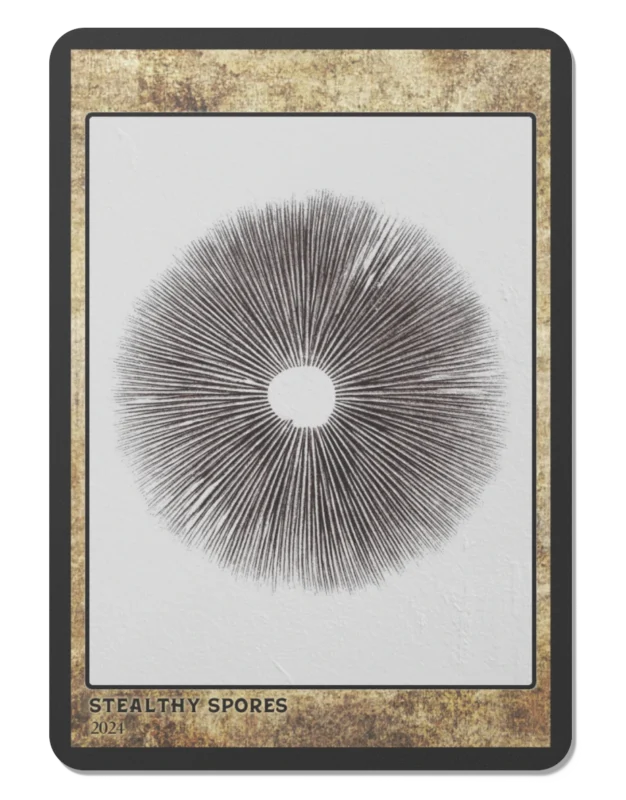
Mushroom Cards
Serve as your primary offensive and defensive tools. They follow Potency and Resistance rules, very similar to MTG’s creature combat rules.
When an attacking mushroom is blocked by another mushroom, they engage in combat. The attacking mushroom’s Potency value challenges the blocking mushroom’s Resistance value, and the blocking mushroom’s Potency value challenges the attacking mushroom’s Resistance value.
- If the attacking mushroom’s Potency value is equal to or greater than the blocking mushroom’s Resistance value, then the blocking mushroom will go to the trash at the end of combat.
- If the attacking mushroom’s Resistance value is equal to or less than the blocking mushroom’s Potency value, then the attacking mushroom will go to the trash at the end of combat.
- During your opponent’s Harvesting Phase, your fruited mushrooms can be used to block your opponent’s mushroom attacks. The Resistance value is the Mushroom’s toughness (damage it takes to destroy it).
- During your Harvesting Phase, your fruited mushrooms can be used to attack your opponent’s Ego. The Potency value is the mushroom’s power (amount of damage it deals).
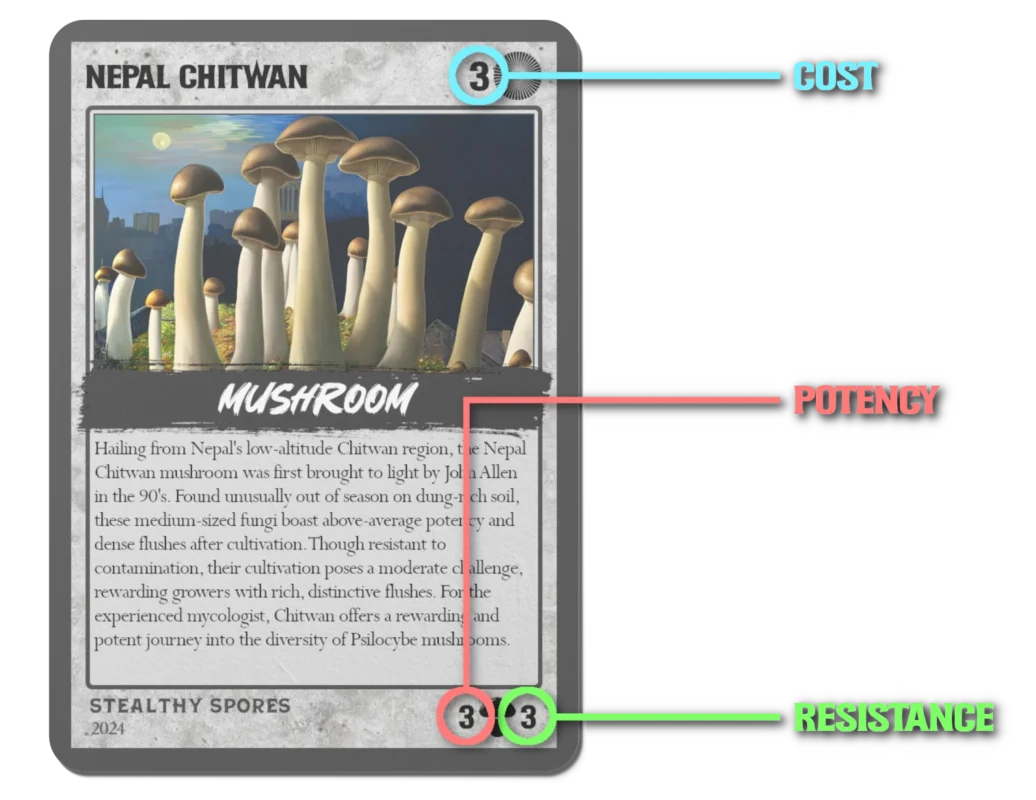
Hero Cards
Offer powerful one-shot or board-based abilities for protection and attack.
- For Defense:
- when summoned to your Fruiting area, the Hero protects you (the player). Per turn, the Hero can absorb/block 5 potency attack points before being destroyed. Your opponent will need to attack with multiple strong mushrooms to break through your blocking mushrooms and your Hero before they can reduce your Ego Points.
- when summoned to your Inoculation area, your Hero will protect your inoculating mushrooms, preventing a Villain from contaminating your grain.
- For Attacking:
- If you have a Hero card in your hand:
- during your Prep Phase, summon your Hero for a one-shot sacrifice attack to destroy a Villain occupying your Inoculation or Fruiting area.
- during your Prep Phase, summon your Hero into your Inoculation area or Fruiting area as a defense mechanism against villains (but only if your opponent doesn’t have a Villain summoned to that area).
- If you have a Hero card in your Inoculation or Fruiting areas:
- during your Prep Phase, use it as a one-shot sacrifice attack to destroy an opponent’s summoned Villain.
- during your Harvest Phase, use it as a one-shot sacrifice attack to destroy an opponent’s summoned Hero.
- If you have a Hero card in your hand:
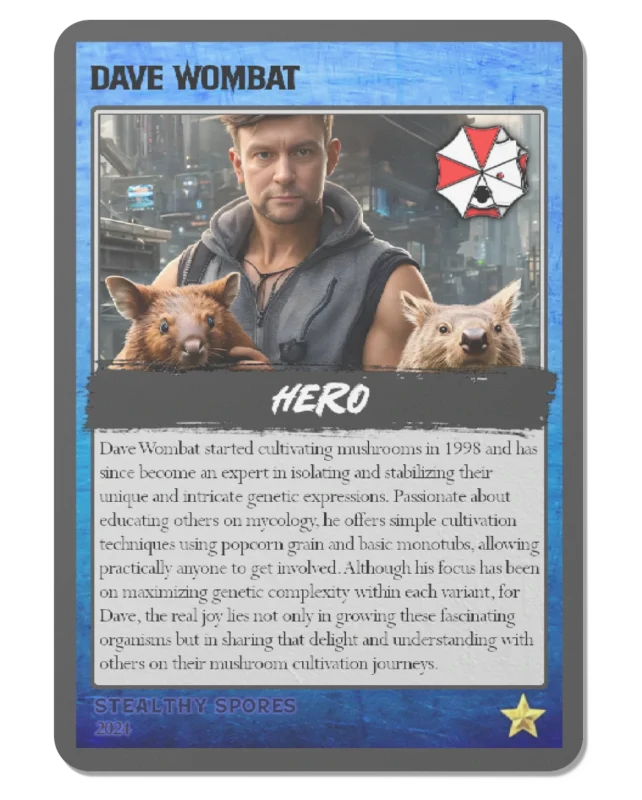
Villain Cards
Disrupt opponents’ strategies with targeted attacks.
- For Attacking:
- If you have a Villain card in your hand:
- during your Prep Phase, summon your Villain for a one-shot sacrifice attack to destroy an opponent’s Spore card.
- during your Prep Phase, summon your Villain for a one-shot sacrifice attack to destroy an opponent’s Hero occupying their Inoculation or Fruiting area.
- during your Prep Phase, summon your Villain into your opponent’s Inoculation or Fruiting zone (but only if your opponent doesn’t have a Hero already summoned to that zone).
- Summoning a Villain to your opponent’s Inoculation zone will send all cards in that zone to the trash bin and prevent them from inoculating new cards until your Villain has been destroyed.
- Summoning a Villain to your opponent’s Fruiting area will send all fruiting (sideways) cards in that zone to the trash bin and prevent them from moving any new colonized cards into the Fruiting area. While your Villain occupies your opponent’s Fruiting area, any Mushroom cards they harvest (attack or defend with), will go to the trash bin at the end of their turn.
- If you have a Villain card in your hand:
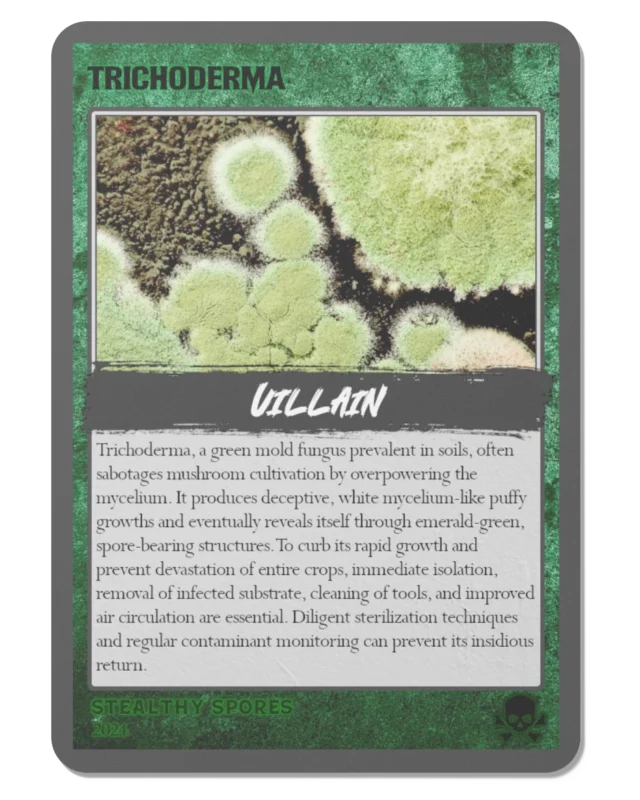
Community Cards
Resurrect a Hero, Villain, or Mushroom card from your trash bin. The resurrected card will go into your hand. A Community card is a one-time use, so discard it to the trash bin once used to resurrect your card.

Cultivator Cards
Double the resistance of one Mushroom card during the Harvesting phase. The cultivator card will bind to the mushroom card for the lifetime of that mushroom.
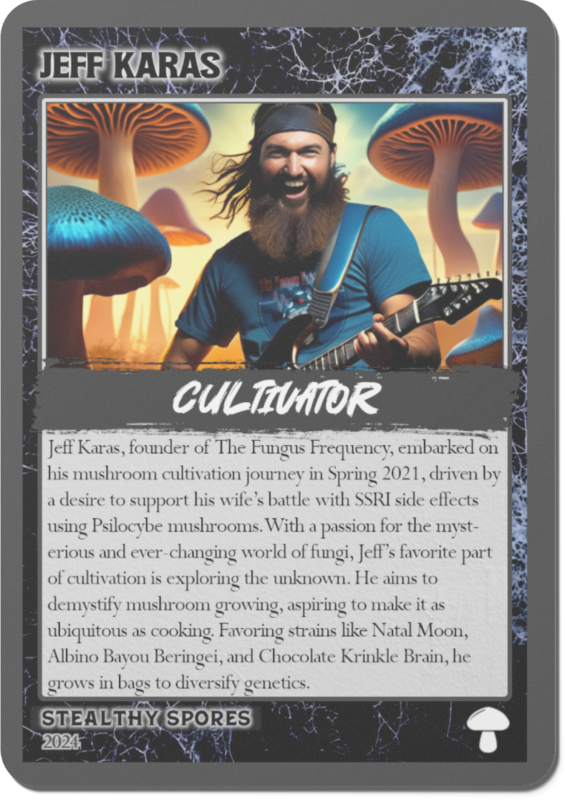
Product Cards
Product cards have dual purpose. They can either:
- Double the potency of one Mushroom card during the Harvesting phase. The product card will bind to the mushroom card for the lifetime of that mushroom.
- Defeat a Villain that’s contaminating a zone.
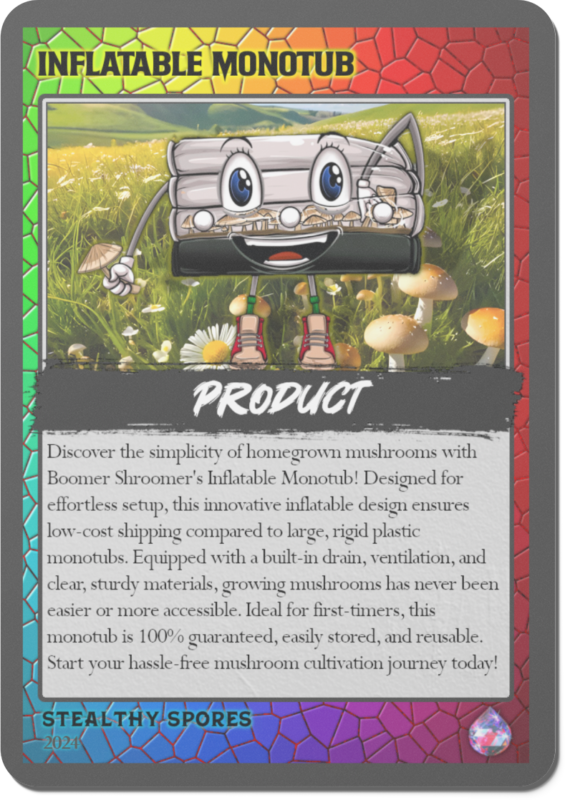
Vendor Cards
Search your deck for a Hero, Villain, Mushroom, or Spore card, reveal it to your opponent, add it to your hand, and then shuffle your deck. A Vendor card is a one-time use, so discard it into your trash bin once used.
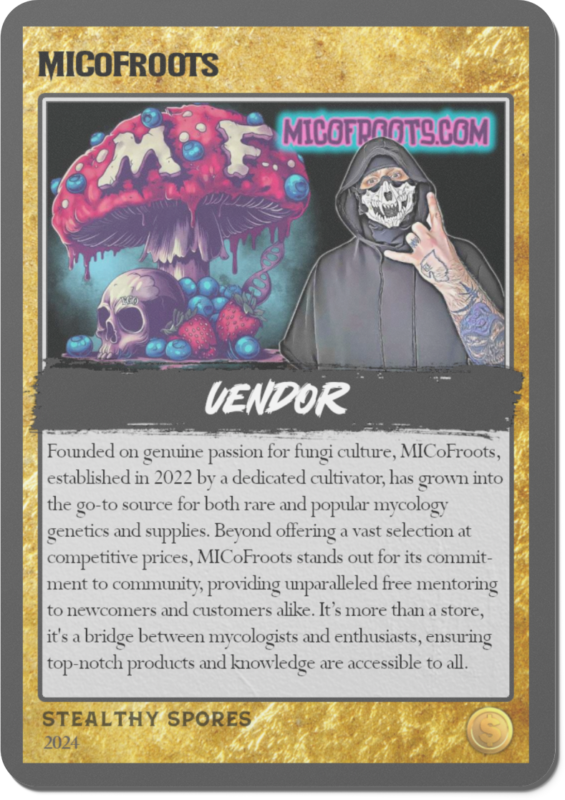
Victory Conditions
Achieve victory by reducing your opponent’s ego points to zero or causing them to deck out. Mastery over your deck and strategic thinking are your keys to success.
